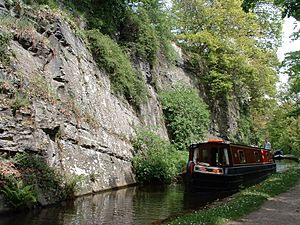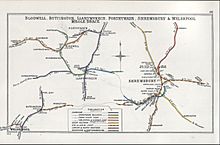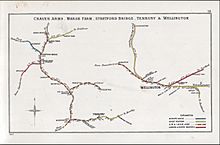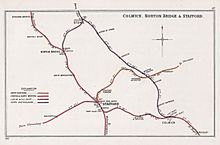Shropshire Union Railways and Canal Company facts for kids
Quick facts for kids Shropshire Union Railways and Canal Co |
|
|---|---|
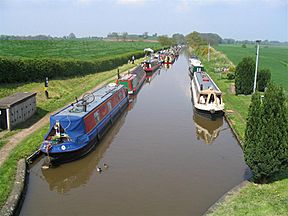
The Shropshire Union Canal near Norbury Junction
|
|
| Specifications | |
| Maximum boat length | 70 ft 0 in (21.34 m) |
| Maximum boat beam | 7 ft 0 in (2.13 m) |
| Status | Most open |
| Navigation authority | Canal and River Trust |
| History | |
| Original owner | Ellesmere and Chester Canal Co |
| Date of act | 1846 |
| Date of first use | 1846 |
| Geography | |
| Start point | Ellesmere Port |
| End point | Autherley Junction |
| Branch(es) | Middlewich Branch; Llangollen Branch; Montgomery Canal; Shrewsbury Canal; Shropshire Canal; Stafford to Shrewsbury Railway |
The Shropshire Union Railways and Canal Company was a company in England. It was created in 1846 to manage several canals and railways. The company planned to change many canals into railways.
However, the London and North Western Railway (LNWR) leased the company from 1847. The LNWR did not want the Shropshire Union to build more railways. Even so, the Shropshire Union continued to manage its canals. It also complained that the LNWR was not using its powers to build more railways.
This company was formed by joining the Chester Canal and the Birmingham and Liverpool Junction Canal. It also took over parts of the Montgomery Canal, the Shrewsbury Canal, and leased the Shropshire Canal. By 1849, plans to convert canals to railways were stopped. But the LNWR bought the Shropshire Canal in 1857. They used it to build a railway to Coalport, which opened in 1861.
Most of the company's money came from carrying goods, not from tolls. They used narrow boats on canals and also carried goods across the River Mersey. This included routes between Liverpool, Ellesmere Port, and Birkenhead. The company made good profits until the 1870s.
Profits then dropped over the next 30 years. In the 1890s, they thought about making the canal bigger for larger boats. This was because the Manchester Ship Canal had opened. But this plan did not happen. Their financial situation improved a little in the early 1900s.
But this changed with the start of the First World War. Government money helped them until 1920. However, rising costs and new work rules made it too expensive to carry goods. The LNWR bought the company in late 1922. On 1 January 1923, the LNWR became part of the London, Midland and Scottish Railway (LMS).
The Montgomery Canal closed in 1936 after a big break. Most of the canals were closed in 1944. The section from Ellesmere Port to Autherley and the Middlewich branch stayed open. These are now called the Shropshire Union Canal. The branch to Llangollen, used for water, is now the Llangollen Canal. Parts of the Montgomery Canal are also being restored.
A small part of the Shropshire Canal is now part of the Ironbridge Gorge Museums. The Stafford to Shrewsbury Line was the only railway built by this canal company. Part of it is still open from Shrewsbury to Wellington. It is used by Transport for Wales.
Contents
A Look Back: The Company's Journey
Early Beginnings
In 1844, two canal companies started talking about joining together. These were the Ellesmere and Chester Canal Company and the Birmingham and Liverpool Junction Canal. The Ellesmere and Chester Canal owned wider canals. These ran from Ellesmere Port to Chester and then to Nantwich, with a branch to Middlewich. The Birmingham and Liverpool Junction Canal was a narrower canal. It went from Nantwich to Autherley.
These two companies had always worked together. They wanted to keep making money, especially with new railways appearing. Joining seemed like a good idea. They agreed in August 1844. Then, they asked the government for permission. This was given on 8 May 1845. The larger Ellesmere and Chester Canal Company was then officially formed.
Becoming a Canal and Railway Company
Soon after, a group was set up to think about turning canals into railways. They also wanted to make their network bigger. They had tried using steam boats to pull other boats. But they realized that trains on railways with good slopes would work better. Other canal companies were worried that canals might close. They thought this would harm their own businesses.
The group met with railway engineer Robert Stephenson in July 1845. He suggested combining different plans to avoid problems in Parliament. George Loch, from the Ellesmere and Chester Canal, worked on the details. This led to the idea of the Shropshire Union. It would combine several railway and canal companies.
The plan included the Eastern and Western parts of the Montgomery Canal. It also included the Shrewsbury Canal and the Shropshire Canal. Most of the canal network would become railways. But about 80 to 90 miles of canals would stay open. This included the Shrewsbury Canal, the Shropshire Canal, and the line from Ellesmere Port to Middlewich. This part was important for carrying salt.
Four new railways were planned. The new company got permission from Parliament in 1846. This allowed them to become the Shropshire Union Railways and Canal Company (SUR&CC). They could take over the Shrewsbury Canal. They could also buy the Montgomery Canal and the Shropshire Canal. The idea was to build railways more cheaply by using existing canal routes.
Changes and Takeovers
The Shropshire Union Company bought the eastern part of the Montgomery Canal in 1847. Three years later, they bought the western part. They decided to lease the Shropshire Canal instead of buying it. They paid £3,125 each year from November 1849. They also started building the Shrewsbury and Stafford Railway. They believed this would not cause canals to lose money.
However, dealing with growing railway companies was tricky. The London and Birmingham Railway saw the Shropshire Union's plans as important. They formed an alliance with other railway companies. But these companies then joined to become the London and North Western Railway (LNWR) in 1846. Suddenly, the Shropshire Union's route was a threat to them.
By late 1846, the LNWR offered to lease the Shropshire Union. The directors thought a steady income from a powerful company was a good idea. They agreed in December. The LNWR got Parliament's approval in June 1847. The Shrewsbury and Stafford Railway opened on 1 June 1849. The LNWR then started paying for the lease.
The LNWR convinced the Shropshire Union not to build more railways. In return, the LNWR promised to help with the canal's debts. So, the Shropshire Union lost its independence quickly. But it continued to manage its canals quite freely.
By 1849, the plan to turn canals into railways was dropped. The Shropshire Canal ran from Wrockwardine Wood to Coalport. After some railway changes, the Shropshire Union manager suggested turning the Shropshire Canal into a railway in 1855. But nothing happened. However, after parts of the canal broke in 1855 and 1856, the LNWR faced expensive repairs.
Instead, they got permission in 1857 to buy the canal. They paid £62,500. They closed the northern part of the canal. Then, they built a railway line along its route. This railway branch to Coalport opened in mid-1861.
Facing Competition and New Ideas
The LNWR tried to build a railway connecting Shrewsbury and other towns in 1853. But they stopped the plan. Other railways were then built by different companies. These new lines often ran next to the canals. The Shropshire Union worked with these companies on prices. They managed to keep canal prices a little lower than railway prices.
In 1861, Robert Skey, the manager, said canals brought a lot of trade to the LNWR. But the relationship with the LNWR was not always easy. The Shropshire Union felt the LNWR was not using its power to control the region with new railways. At this time, the Shropshire Union was busy upgrading a tramway. This allowed locomotives to run on it.
By 1869, the Shropshire Union had a busy business carrying goods. They moved goods from Liverpool across the River Mersey to Ellesmere Port and Birkenhead. The LNWR also did cross-river trade. They transferred this to the Shropshire Union in 1870. The company bought other carrying businesses too.
The company was limited in what goods it could carry by its lease with the LNWR. They made good profits until the late 1860s. But this profit did not cover all their costs. Most of their money came from carrying goods, not from tolls. They owned many narrowboats to do this work. They had 213 boats in 1870, and 450 by 1902.
At Ellesmere Port, the Manchester Ship Canal changed things. From 1891, all traffic from the port had to use the canal. The Shropshire Union built a new quay for ships. They also looked into making their canal line bigger for larger boats. This would have cost a lot of money. They also talked about a large canal from the Mersey to Birmingham. But neither of these big plans happened.
The Decline and End of an Era
For the last 30 years of the 1800s, the Shropshire Union made a small profit. But it was not enough to cover all its costs. The situation got better in the early 1900s. But it quickly got worse when the First World War started. Government money helped them after the war. But wages were much higher, and raw materials cost more.
When government money stopped in August 1920, the business was no longer making enough money. Boat families were told that carrying goods would stop. But the canals would stay open for private boats. The Ellesmere Port facilities were leased to the Manchester Ship Canal. The Great Western Railway took over the Liverpool facilities.
In late 1922, the LNWR bought out the Shropshire Union Company. A few days later, in early 1923, the LNWR became part of the London, Midland and Scottish Railway (LMS). This was part of a big change where most British railways joined into four large groups.
After this, the canals slowly declined. Less maintenance made it harder for boats to use them. The Weston Branch of the Montgomery Canal closed in 1917. Most of the main line closed in 1936 after a break in the canal.
Finally, the LMS got permission in 1944 to close many canals. For the Shropshire Union system, this meant the Montgomery Canal, the Shrewsbury Canal, and the remaining part of the Shropshire Canal were closed. Only the main line from Ellesmere to Autherley and the Middlewich branch stayed open. The branch to Llangollen was also kept, but only to supply water to the canal.
Shropshire Union Railways Today
The Shropshire Union Company built one of the few railways in England made by a canal company. This was the Stafford to Shrewsbury Line. It went through Newport and Wellington. The Shropshire Union Company was fully in charge of the section from Stafford to Wellington. But the 10.5-mile section between Shrewsbury and Wellington was shared with the Shrewsbury and Birmingham Railway.
After the LNWR took over, the Shrewsbury and Wellington Railway was run jointly. It was managed by the Great Western Railway and the LNWR. The Stafford to Shrewsbury Railway opened on 1 June 1849. It was about 29.25 miles long. The London and North Western Railway leased the line from July 1847, even before it was finished.
What's Left of the Railways Today?
The Shrewsbury and Wellington section is still used today. Transport for Wales runs services on it.
Passenger trains on the Stafford to Wellington section stopped on 7 September 1964. Goods trains stopped between Stafford and Newport on 1 August 1966. This branch from Wellington was shortened to Donnington on 22 November 1969.
In 2009, a report suggested reopening the line from Stafford to Wellington. This was part of a plan to open many stations closed in the Beeching Axe.
The Canals Today
As of 2017, the main canal line from Ellesmere Port to Autherley is still open. The branch to Middlewich is also open. These are now called the Shropshire Union Canal. The branch from Hurleston Junction to Llangollen has been reopened for boats. It has been called the Llangollen Canal since the mid-1950s.
The Montgomery Canal has been partly reopened. The first part restored was at Welshpool in 1969. This happened because a new road threatened the canal's path. The section south from Frankton Junction has been slowly reopened since 1987. More parts were opened in 1995, 1996, 2003, 2007, and 2014. Work is still ongoing to restore most of the remaining closed sections.
A group called a Trust has been set up to protect the remains of the Shrewsbury Canal. They hope to reopen it in the future. Studies in 2004 found no major problems to stop a full reopening.
A short part of the Shropshire Canal is now part of the Ironbridge Gorge Museums. This includes the Hay Inclined Plane. Water is still in the canal near the old Madeley Wood Brick and Tile Works. The section at the bottom of the inclined plane at Coalport also has water. The inclined plane was partly restored in the 1970s and again in the 1990s.


